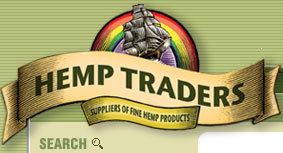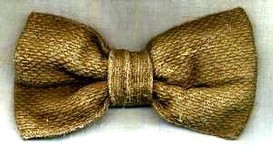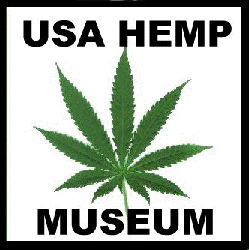 |
HEMP TEXTILE ROOM
USA Hemp Museum
Store |
|
ROOM GUIDE
|
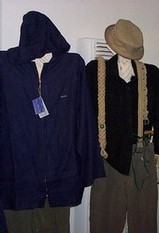 |
||||||||||||||||||
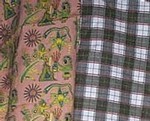 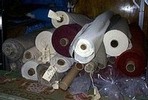 |
|
|
Ecolution by ThinkOrganic.com
HEMP FASHION LINKS Hemp Fashions
1. WELCOME TO THE HEMP TEXTILE AND FABRIC ROOM. Welcome to the room guide full of hyperlinks. This is the hemp textile room. People made hemp fabric thousands of years before the advent of written language. Hemp ropes and sails were the backbone of the sailing ship's service to people for 6,000 years. Our first flag was made of sailcloth hemp. My mother was born in the hemp growing state of Missouri, so she knew what hemp was from her family. She did not know it was illegal to grow. Scroll down through this room first. I left a picture up for each sub-room so you could get an overview. According to HEMPTECH in Industrial Hemp,
1995, the manufacture of textiles is the third largest
industry in the world. In 1938, hemp was used to produce
more than 5,000 textile products. We have lots more to add, so come see us again. |
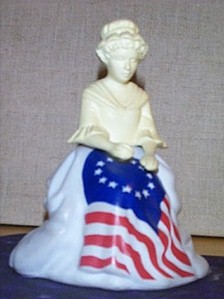 |
U.S.A. Hemp Museum perfume bottle
showing Betsy Ross sewing the first United States flag out of hemp
sailcloth.
Betsy Ross made the first flag of the United
States of America out of the finest, strongest fiber available,
hemp fabric. |
Hemp makes great clothing, linens, lace, upholstery material, rugs, strapping, fire hose, sailcloth and canvas. Fabrics made from hemp are more insulating, softer, stronger, more water absorbent and last many times longer than cotton. At this very moment I am wearing a shirt made of 100% hemp, imported from China, (available from many U.S. manufacturers). This amazing plant fiber holds its shape as well as polyester, but "breathes" and is biodegradable because it is a completely natural fiber. It has been valued for its durability since before recorded history. |
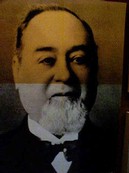 |
LEVI STRAUSS, Merchant. (1829-1902). Imagination is basic to business success. Levi came to America from Bavaria in 1847, understood the potential value of cloth and astute merchandising. The California Gold Rush drew him to San Francisco, where his dry goods business flourished. Twenty years later, he began manufacturing pants, the first made out of a light-weight duck canvas. - Thanks to the Skirball Museum, L.A.,CA. |
|
|
| Hemp can be woven as coarse as burlap, smooth as silk, or intricate as lace. The canvas sails on thousands of years of ships and covers for the covered wagons were all made of hemp. The quality of this natural fiber has yet to be surpassed. This natural cycle of life can be used by the entire world, greatly reducing our foreign aid as nations prosper with hemp. Over the 1800's, hemp was gradually replaced by cheaper foreign fibers. By the 1930's, we as a nation were so far removed from the natural cycle of hemp, that people believed the lie (by our own government, of course) that hemp was some new killer weed with their made up name of marijuana. Hemp is the Creator's gift to humanity, as our Constitution recognizes. |
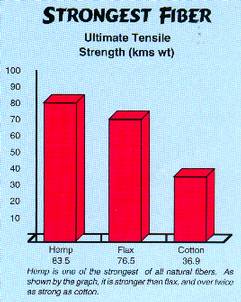 |
Hemp is one of the strongest of all
natural fibers. As shown on the graph, it is stronger than
flax, and over twice as strong as cotton. -Graph from Hemp
Traders flyer. Phone: 310-914-9557.
|
| One of the major reasons for ending hemp prohibition is that hemp can replace cotton as the nation's primary fiber. From The Emperor: "Finally, it must be noted that approximately 50% of all chemicals (pesticides, herbicides, etc.) used in American agriculture today are used in cotton growing. Hemp needs no chemicals, has virtually no weed or insect enemies -except for the U.S. Government and the DEA." It is one of the major challenges of this decade, that we find alternatives to the poisons of the synthetic society. The EPA Superfund cleanup program for a fraction of the toxic dumps in our country may cost as much as one trillion dollars. These chemicals, many of which are persistent in the environment, have poisoned our earth, our water, our food and ourselves. To be able to get rid of half of these agricultural poisons by replacing cotton with hemp, would be a major environmental miracle. |
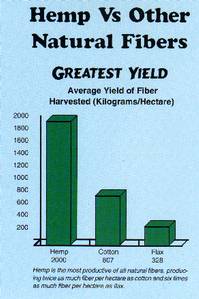 |
Hemp is the most productive of all natural fibers, producing over twice as much fiber per hectare as cotton and six times as much fiber per hectare as flax. And with less water. Again we need to go with the natural cycles, in insect control, in weed control, but also in farming in general. I love growing hemp. Given normal conditions, it simply outgrows insect pests and shades out weeds. Hemp after all, is the fastest growing economically important plant. We should recognize that hemp instead of cotton is national health insurance. |
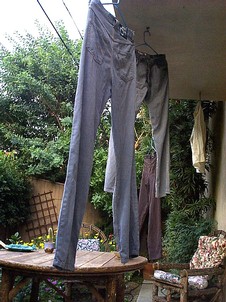 |
Photo: Hemp garments drying on the
porch.
As curator of the hemp museum, I have attempted to have at least one hemp garment on my person at all times for the past 10 years. I love to wear hemp. My present wardrobe consists of 12 shirts, 6 pants, 9 vests, 2 socks, 2 caps, and two jackets. I would guess that thousands of people have reached out and touched hemp fabric for the first time on my person. The buying of a hemp garment from a growing hemp industry can be a revolutionary and peaceful act that will force the day of reckoning. |
|
***** Page 70: "For in trying to recount the origins of linen and fabrics, the storyteller confronts the irreparable damage of time. Textiles are the most perishable of materials, and so from the Neolithic Age (when archaeologists think mankind first began to weave flax and hemp) to the end of the Middle Ages, the history of fabrics is recorded on just a few shreds of cloth whose exact features are difficult to determine."
|
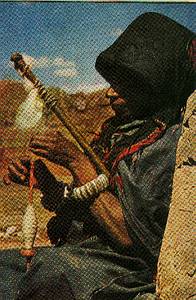 |
A hand spinner of today uses an ages
old technique with her tools. Fiber unknown.
Life magazine photo in the Hemp Museum. |
3. Hemp Fashion Companies
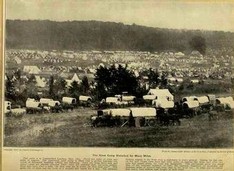 |
Hemp wagon covers and tents in the Civil War. All the white is hemp. |
6. HEMP FABRIC SAMPLES & BLENDS
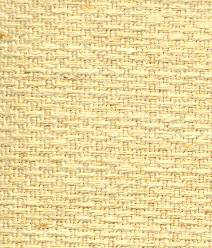 |
The Chinese hemp fabric pictured on the left in its natural color is some of the first imported in the new hemp revival of the 1990's. It is a medium weight basket weave that was made into shirts, vests, robes, hats, and the bowtie (shown below by Brenda Kershenbaum) in the early days of the revival. The 22 fabric samples in this section are just a start. The Museum has many more. |
|
|
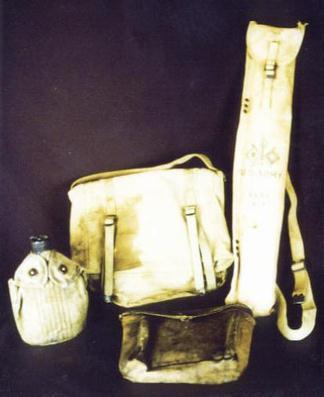 |
Some military canvas in the museum
collection (left), some of which may be from other fibers, includes a
canteen cover, gas mask bag, signal flags and case, and
pouch. Other canvas items in the collection are a
military sleeping pack from 1935, a camera tripod case,
boot leggings, an umbrella, shoes, ammo belts, and belts.
More on the way.
Photo: Bill Bridges |
11. SAILING SHIPS The age of hemp, has 54 pictures of ships from the Hemp Museum collection.
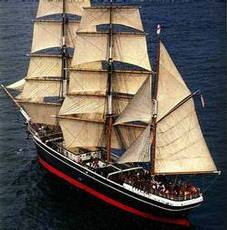 |
STAR OF INDIA. The reconstructed metal hulled sailing ship is home-ported in San Diego Harbor at the San Diego Marine Maritime Museum. Launched in 1863, it was one of the first metal-hulled ships built. |
16. HEMP TEXTILE PRODUCTS From the Hemp Museum collection.
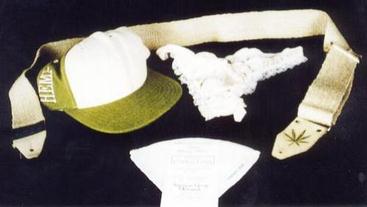 |
Hemp cap, guitar strap, women's
panties are a hemp - silk blend. Lower, hemp fabric coffee
filter.
Photo: Bill Bridges |
If you would like to join the USA Hemp Museum
or communicate with the curator, send an
email to
Richard M. Davis:
Curator, Founder, Author
Help support the USA Hemp Museum
Please Make A
Donation
To The USA Hemp Museum's Building Fund
So We Can Make Public Our Collection
Of
Over 1,700 Hemp History Items
and/or buy the books
Richard M. Davis
IF YOU ARE A
FASHION DESIGNER, CONSIDER WORKING WITH HEMP.
NON TOXIC,

ECO FRIENDLY, VERSATILE, STRONG AND BEAUTIFUL
